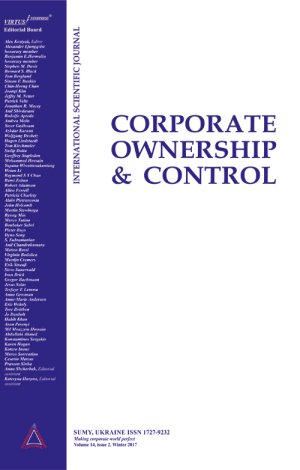
-
 Journal menu
Journal menu

- General information
- Editorial Board and External Reviewers
- Journal Policies
- Publication Ethics and Malpractice Statement
- Instructions for authors
- Paper reviewing
- Article processing charge
- Feedback from stakeholders
- Journal’s Open Access statement
- Order hard copies of the journal
- 50 most cited papers in the journal
A STUDY OF DISCRETIONARY NARRATIVE DISCLOSURE STRATEGIES OF THE MOST AND LEAST PROFITABLE MENA REGION BANKS
Download This ArticleAbstract
The study aims to investigate whether the discretionary narrative disclosure strategies (DNDS) of impression management (IM) adopted by different banks in the narrative section of 200 annual reports of a sample of 50 banks in five different countries of Middle East and North Africa (MENA) region (Egypt, Jordan, Lebanon, Saudi Arabia, and United Arab of Emirates) vary according to their profitability for 2011-2014. Seven variables were employed to identify the association between profitability and the extent of existence of DNDS of IM in the chairmen’s letters of the bank’s annual reports. These variables are reading ease manipulation (REM), rhetorical manipulation (RM), thematic manipulation (TM), visual and structural implementation (VSM), performance comparisons (PC), choice of earnings number (CEN), and performance attribution (PA). By employing an independent sample t -test, it was found that three out of the seven strategies have differed significantly between banks in terms of profitability. These strategies are REM, PC, and CEN. Specifically, more profitable banks use very difficult language; selects favorable benchmark from prior years; and don’t select favorable earnings number in annual reports narrative. It is interesting to note that banks in MENA region produce narratives – especially the chairmen’s letter the discretionary disclosure section- to influence the perception of their stakeholders rather than to display the narratives in accordance with the “true and fair view” principle of accounting. Therefore, this study recommends regulators for more actively intervening to ensure that the voluntary status of the annual reports is more closely scrutinized by auditors in order to reduce the negative effects of DNDS of IM.
Keywords: Impression Management, Discretionary Narrative Disclosure Strategies, Annual Report, Chairman’s Letter, MENA Region, Profitability
JEL Classification:M41
Date received: 27 October 2016
Date accepted: 13 January 2017
How to cite this paper: Mahboub, R., Mostapha, N., & Hegazy, W. (2017). A study of discretionary narrative disclosure strategies of the most and least profitable MENA region banks. Corporate Ownership & Control, 14(2-1), 258-267. https://doi.org/10.22495/cocv14i2c1p12

















